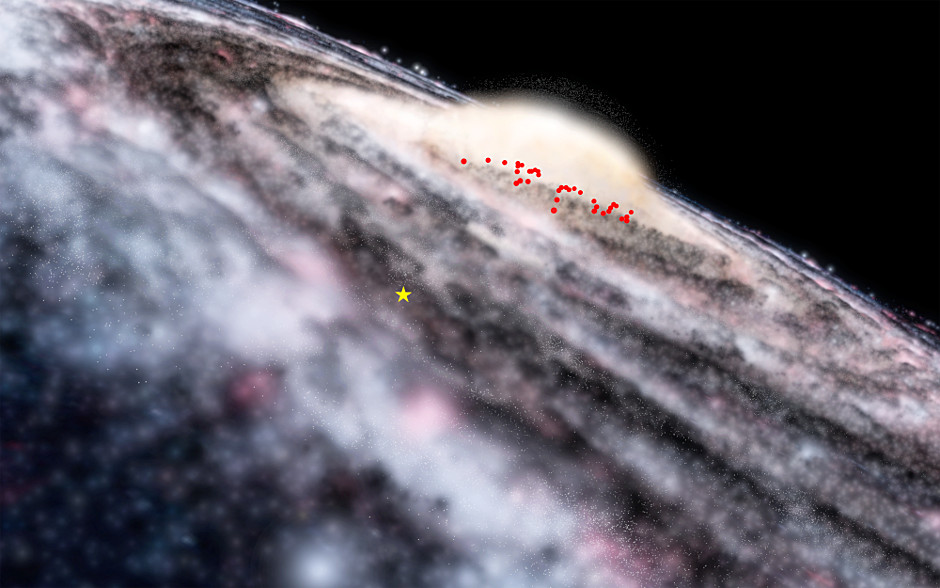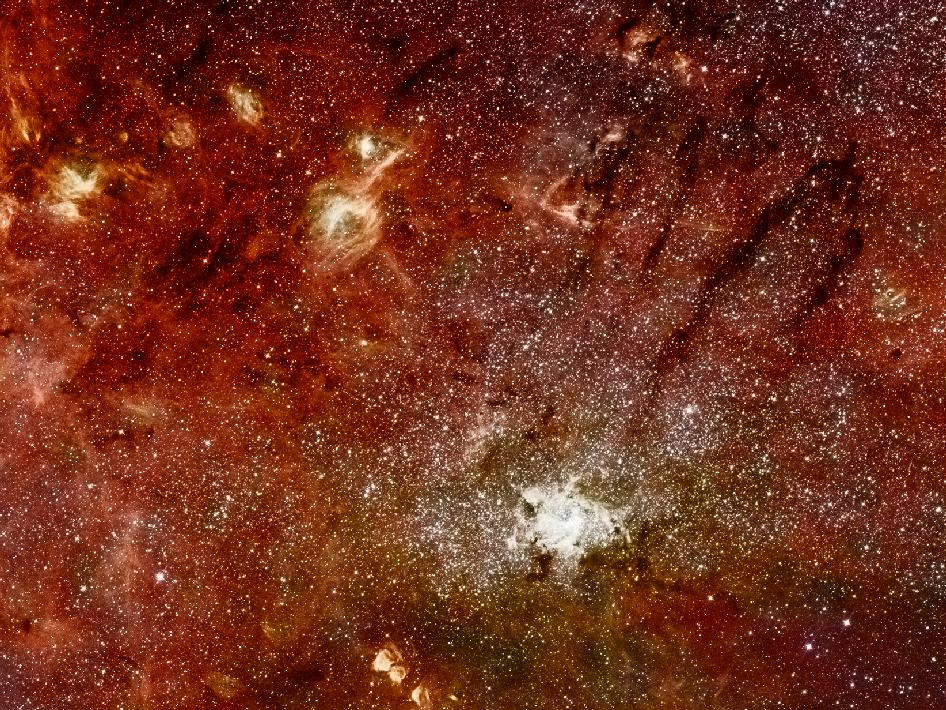AnnAstronomers using the VISTA telescope at ESO’s Paranal Observatory have discovered a previously unknown component of the Milky Way. By mapping out the locations of a class of stars that vary in brightness called Cepheids, a disc of young stars buried behind thick dust clouds in the central bulge has been found. This diagram shows the locations of the newly discovered Cepheids in an artist’s rendering of the Milky Way. The yellow star indicates the position of the Sun. Image credit: ESO/Microsoft WorldWide Telescope.[/b]
The Vista Variables in the Vía Láctea Survey (VVV) ESO public survey is using the VISTA telescope at the Paranal Observatory to take multiple images at different times of the central parts of the galaxy at infrared wavelengths. It is discovering huge numbers of new objects, including variable stars, clusters and exploding stars.
A team of astronomers, led by Istvan Dékány of the Pontificia Universidad Católica de Chile, has now used data from this survey, taken between 2010 and 2014, to make a remarkable discovery — a previously unknown component of our home galaxy, the Milky Way.
“The central bulge of the Milky Way is thought to consist of vast numbers of old stars. But the VISTA data has revealed something new — and very young by astronomical standards!” says Istvan Dékány, lead author of the new study...
VISTA telescope discovers new component of Milky Way
VISTA telescope discovers new component of Milky Way
VISTA telescope discovers new component of Milky Way
Color Commentator
- geckzilla
- Ocular Digitator
- Posts: 9180
- Joined: Wed Sep 12, 2007 12:42 pm
- Location: Modesto, CA
- Contact:
Re: VISTA telescope discovers new component of Milky Way
Well, that must delight you to think that our galaxy has its very own circumnuclear ring.
Just call me "geck" because "zilla" is like a last name.
ESO: VISTA Discovers New Component of Milky Way
VISTA Discovers New Component of Milky Way
European Southern Observatory | VISTA | VVV Survey | 2015 Oct 28
The VVV Survey reveals classical Cepheids tracing a young and thin stellar disk across the Galaxy's bulge - Istvan Dékány et al
http://asterisk.apod.com/viewtopic.php?t=34351
European Southern Observatory | VISTA | VVV Survey | 2015 Oct 28
Astronomers using the VISTA telescope at ESO’s Paranal Observatory have discovered a previously unknown component of the Milky Way. By mapping out the locations of a class of stars that vary in brightness called Cepheids, a disc of young stars buried behind thick dust clouds in the central bulge has been found.
The Vista Variables in the Vía Láctea Survey (VVV) [1] ESO public survey is using the VISTA telescope at the Paranal Observatory to take multiple images at different times of the central parts of the galaxy at infrared wavelengths [2]. It is discovering huge numbers of new objects, including variable stars, clusters and exploding stars (eso1101, eso1128, eso1141). ...
Click to play embedded YouTube video.
Click to play embedded YouTube video.
- Astrophysical Journal Letters 812(2):L29 (2015 Oct 20) DOI: 10.1088/2041-8205/812/2/L29
arXiv.org > astro-ph > arXiv:1509.08402 > 28 Sep 2015
http://asterisk.apod.com/viewtopic.php?t=34351
Know the quiet place within your heart and touch the rainbow of possibility; be
alive to the gentle breeze of communication, and please stop being such a jerk. — Garrison Keillor
alive to the gentle breeze of communication, and please stop being such a jerk. — Garrison Keillor
- neufer
- Vacationer at Tralfamadore
- Posts: 18805
- Joined: Mon Jan 21, 2008 1:57 pm
- Location: Alexandria, Virginia
Re: VISTA telescope discovers new component of Milky Way
The Milky Way's tiny (3 pc ?) circumnuclear ring seen with Sophia (http://svs.gsfc.nasa.gov/cgi-bin/details.cgi?aid=30497) is distinct from the much larger "5-kpc ring" probably being observed by VISTA:geckzilla wrote:
Well, that must delight you to think that our galaxy has its very own circumnuclear ring.
https://en.wikipedia.org/wiki/Milky_Way wrote:
<<The Sun is 26,000–28,000 ly (8.0–8.6 kpc) from the Galactic Center. In the inner few kpc (around 10,000 light-years radius) is a dense concentration of mostly old stars in a roughly spheroidal shape called the bulge. It has been proposed that the Milky Way lacks a bulge formed due to a collision and merger between previous galaxies and that instead has a pseudobulge formed by its central bar.
The nature of the Milky Way's bar is actively debated, with estimates for its half-length and orientation spanning from 1 to 5 kpc (3,000–16,000 ly) and 10–50 degrees relative to the line of sight from Earth to the Galactic Center. Certain authors advocate that the Milky Way features two distinct bars, one nestled within the other. However, RR Lyr variables do not trace a prominent Galactic bar. The bar may be surrounded by a ring called the "5-kpc ring" that contains a large fraction of the molecular hydrogen present in the Milky Way, as well as most of the Milky Way's star-formation activity. Viewed from the Andromeda Galaxy, it would be the brightest feature of the Milky Way. X-ray emission from the core is aligned with the massive stars surrounding the central bar and the Galactic ridge.
Astronomers first began to suspect that the Milky Way is a barred spiral galaxy, rather than an ordinary spiral galaxy, in the 1990s. Their suspicions were confirmed by the Spitzer Space Telescope observations in 2005 that showed the Milky Way's central bar to be larger than previously thought.>>
Art Neuendorffer
- geckzilla
- Ocular Digitator
- Posts: 9180
- Joined: Wed Sep 12, 2007 12:42 pm
- Location: Modesto, CA
- Contact:
Re: VISTA telescope discovers new component of Milky Way
I had no idea there was a possible ring around Sgr A*. Of course, when speaking to Ann, one need not make such distinctions... 
Just call me "geck" because "zilla" is like a last name.
Re: VISTA telescope discovers new component of Milky Way
NGC 1097. Photo: ESO
Indeed, I was glad to hear about the circumnuclear ring of the Milky Way, for two reasons. Me being me, I'm obviously glad to hear about any recently discovered blue structures in the Milky Way. And two, I'm also glad to learn that the structure of the Milky Way, a barred galaxy, resembles the structure of other barred galaxies. Barred galaxies typically have circumnuclear rings dominated by young blue stars. At left is a fine example, NGC 1097.geckzilla wrote:Well, that must delight you to think that our galaxy has its very own circumnuclear ring.
geckzilla wrote:I had no idea there was a possible ring around Sgr A*. Of course, when speaking to Ann, one need not make such distinctions...
I want to thank Art for bringing up the very small (3 pc?) circumnuclear ring of the Milky Way, and for explaining that the newly discovered structure is very much larger. But I'd like to say something about the small circumnuclear ring, too. It is clear from the picture at right that the circumnuclear ring is a very bright feature. It is also well known that almost all large galaxies have very bright, quite small nuclei. One example of many is grand design spiral galaxy M74:
Circumnuclear ring of the Milky Way. Photo: HST
My guess is that most large spiral galaxies have very bright, tight clusters surrounding their black holes. For those galaxies that don't have an active nucleus, it will be the central bright cluster that makes the nucleus so bright.http://messier.seds.org/m/m074.html wrote:
The nucleus of Sc spiral galaxy M74 is small and bright.
And because of the circumnuclear cluster (or ring) the Milky Way must have a bright nucleus. But our galaxy will in all likelihood also have a much larger ring that is clearly set apart from the nucleus itself.
Ann
Last edited by bystander on Thu Oct 29, 2015 12:57 am, edited 2 times in total.
Reason: Please, no hotlinks to images > 500Kb. Substituded smaller image.
Reason: Please, no hotlinks to images > 500Kb. Substituded smaller image.
Color Commentator



